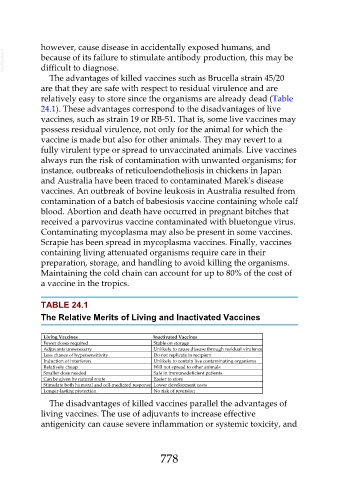Page 778 - Veterinary Immunology, 10th Edition
P. 778
however, cause disease in accidentally exposed humans, and
VetBooks.ir because of its failure to stimulate antibody production, this may be
difficult to diagnose.
The advantages of killed vaccines such as Brucella strain 45/20
are that they are safe with respect to residual virulence and are
relatively easy to store since the organisms are already dead (Table
24.1). These advantages correspond to the disadvantages of live
vaccines, such as strain 19 or RB-51. That is, some live vaccines may
possess residual virulence, not only for the animal for which the
vaccine is made but also for other animals. They may revert to a
fully virulent type or spread to unvaccinated animals. Live vaccines
always run the risk of contamination with unwanted organisms; for
instance, outbreaks of reticuloendotheliosis in chickens in Japan
and Australia have been traced to contaminated Marek's disease
vaccines. An outbreak of bovine leukosis in Australia resulted from
contamination of a batch of babesiosis vaccine containing whole calf
blood. Abortion and death have occurred in pregnant bitches that
received a parvovirus vaccine contaminated with bluetongue virus.
Contaminating mycoplasma may also be present in some vaccines.
Scrapie has been spread in mycoplasma vaccines. Finally, vaccines
containing living attenuated organisms require care in their
preparation, storage, and handling to avoid killing the organisms.
Maintaining the cold chain can account for up to 80% of the cost of
a vaccine in the tropics.
TABLE 24.1
The Relative Merits of Living and Inactivated Vaccines
Living Vaccines Inactivated Vaccines
Fewer doses required Stable on storage
Adjuvants unnecessary Unlikely to cause disease through residual virulence
Less chance of hypersensitivity Do not replicate in recipient
Induction of interferon Unlikely to contain live contaminating organisms
Relatively cheap Will not spread to other animals
Smaller dose needed Safe in immunodeficient patients
Can be given by natural route Easier to store
Stimulate both humoral and cell-mediated response Lower development costs
Longer-lasting protection No risk of reversion
The disadvantages of killed vaccines parallel the advantages of
living vaccines. The use of adjuvants to increase effective
antigenicity can cause severe inflammation or systemic toxicity, and
778

